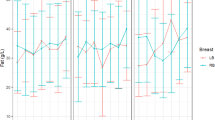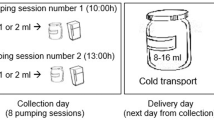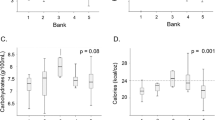Abstract
Objective
Energy values for human milk are increasingly available clinically, though there are no standards for deriving these values. We compared published calorie methods using a common set of samples.
Study design
Ten human milk samples were measured for gross and digestible macronutrients using laboratory methods. Four calorie conversion factors were used: Atwater general (ATW-GEN); Atwater milk specific (ATW-MILK), human milk specific (HUM-MILK), and combustible conversions (COMBUST). Differences in derived calories were assessed using ANOVA.
Results
There was a significant difference (P < 0.001) in calorie values between methods. Gross macronutrients with COMBUST conversion factors produced the highest calorie values (19.4 ± 1.4 kcal/ounce) whereas digestible macronutrients with HUM-MILK conversion factors produced the lowest calorie values (16.3 ± 1.3 kcal/ounce). Mean difference between these values was 3.1 kcal/ounce (95% CI 2.5, 3.7).
Conclusion
Mean calorie difference of 3.1 kcal/ounce is clinically important for preterm infants, suggesting the need for standardization.
This is a preview of subscription content, access via your institution
Access options
Subscribe to this journal
Receive 12 print issues and online access
$259.00 per year
only $21.58 per issue
Buy this article
- Purchase on Springer Link
- Instant access to full article PDF
Prices may be subject to local taxes which are calculated during checkout

Similar content being viewed by others
References
Stoltz Sjöström E, Öhlund I, Ahlsson F, Engström E, Fellman V, Hellström A, et al. Nutrient intakes independently affect growth in extremely preterm infants: results from a population-based study. Acta Pædiatrica. 2013;102:1067–74.
Asbury MR, Unger S, Kiss A, Ng DVY, Luk Y, Bando N, et al. Optimizing the growth of very-low-birth-weight infants requires targeting both nutritional and nonnutritional modifiable factors specific to stage of hospitalization. Am J Clin Nutr. 2019;110:1384–94.
Horbar JD, Ehrenkranz RA, Badger GJ, Edwards EM, Morrow KA, Soll RF, et al. Weight growth velocity and postnatal growth failure in infants 501 to 1500 grams: 2000-2013. Pediatr Pediatr. 2015;136:e84–92.
American Academy of Pediatrics Section on Breastfeeding. Breastfeeding and the use of human milk. Pediatrics. 2012;129:827–41.
American Academy of Pediatrics Committee on Nutrition, Section on Breastfeeding, Committee on Fetus and Newborn. Donor human milk for the high-risk infant: preparation, safety, and usage options in the United States. Pediatrics. 2017; 139: https://doi.org/10.1542/peds.2016-3440.
Kleinman RE, Greer FR. Pediatric Nutrition, 8th ed. American Academy of Pediatrics; 2019. 1460 p. https://ebooks.aappublications.org/content/9781581108194/9781581108194.
Wojcik KY, Rechtman DJ, Lee ML, Montoya A, Medo ET. Macronutrient analysis of a nationwide sample of donor breast milk. J Am Diet Assoc. 2009;109:137–40.
Perrin MT, Fogleman AD, Newburg DS, Allen JC. A longitudinal study of human milk composition in the second year postpartum: implications for human milk banking. Matern Child Nutr. 2017; 13: https://doi.org/10.1111/mcn.12239.
Jo DB, Hagadorn JI, Smith KC, Esposito PA, Brownell EA. Macronutrient analysis of donor human milk labelled as 24 kcal/oz. J Perinatol 2020;40:666–71.
Jensen RG, Neville M. Human lactation: milk components and methodologies. New York, NY: Plenum Press; 1985.
Gidrewicz DA, Fenton TR. A systematic review and meta-analysis of the nutrient content of preterm and term breast milk. BMC Pediatr. 2014; 14: https://doi.org/10.1186/1471-2431-14-216.
Wu X, Jackson RT, Khan SA, Ahuja J, Pehrsson PR. Human milk nutrient composition in the United States: current knowledge, challenges, and research needs. Curr Dev Nutr. 2018;2:nzy025.
United States Food and Drug Adminstration. FDA permits marketing of a diagnostic test to aid in measuring nutrients in breast milk. FDA. 2019. http://www.fda.gov/news-events/press-announcements/fda-permits-marketing-diagnostic-test-aid-measuring-nutrients-breast-milk.
Perrin MT, Festival J, Starks S, Mondeaux L, Brownell EA, Vickers A. Accuracy and reliability of infrared analyzers for measuring human milk macronutrients in a milk bank setting. Curr Dev Nutr 2019;3:nzz116.
Coppa GV, Gabrielli O, Pierani P, Catassi C. Changes in carbohydrate composition in human milk over 4 months of lactation. Pediatrics. 1993;91:637–41.
Sullivan D, Carpenter D. Methods of analysis for nutrition labeling. Arlington, VA: AOAC International; 1993.
Lonnerdal B. Nutritional and physiologic significance of human milk proteins. Am J Clin Nutr. 2003;77:S1537.
Lönnerdal B, Forsum E, Hambraeus L. A longitudinal study of the protein, nitrogen, and lactose contents of human milk from Swedish well-nourished mothers. Am J Clin Nutr. 1976;29:1127–33.
Feng P, Gao M, Burgher A, Zhou TH, Pramuk K. A nine-country study of the protein content and amino acid composition of mature human milk. Food Nutr Res. 2016;60:31042.
Jensen RG, Bitman J, Carlson SE, Couch SC, Hamosh M, Newburg DS. Milk lipids. In: Jensen RG (ed) Handbook of milk composition. Academic Press: San Diego, 1995, pp 495–537.
McGuire MK, Meehan CL, McGuire MA, Williams JE, Foster J, Sellen DW, et al. What’s normal? Oligosaccharide concentrations and profiles in milk produced by healthy women vary geographically. Am J Clin Nutr. 2017;105:1086–100.
Autran CA, Kellman BP, Kim JH, Asztalos E, Blood AB, Spence ECH, et al. Human milk oligosaccharide composition predicts risk of necrotising enterocolitis in preterm infants. Gut. 2018;67:1064–70.
Food and Agriculture Organization of the United Nations. Food energy - methods of analysis and conversion factors. 2002. http://www.fao.org/uploads/media/FAO_2003_Food_Energy_02.pdf.
Southgate DA, Barrett IM. The intake and excretion of calorific constituents of milk by babies. Br J Nutr. 1966;20:363–72.
Anderson GH, Atkinson SA, Bryan MH. Energy and macronutrient content of human milk during early lactation from mothers giving birth prematurely and at term. Am J Clin Nutr. 1981;34:258–65.
Miris HMA Human Milk Analyzer User Manual. 2017. https://www.mirissolutions.com/support/user-manuals.
De Curtis M, Senterre J, Rigo J, Putet G. Carbohydrate derived energy and gross energy absorption in preterm infants fed human milk or formula. Arch Dis Child. 1986;61:867–70.
Peila C, Moro GE, Bertino E, Cavallarin L, Giribaldi M, Giuliani F, et al. The effect of Holder pasteurization on nutrients and biologically-active components in donor human milk: a review. Nutrients. 2016; 8: https://doi.org/10.3390/nu8080477.
Funding
MTP received research gifts from Mothers’ Milk Bank of North Texas, Northwest Mothers Milk Bank, and NorthernStar Mothers Milk Bank which were used to support this study.
Author information
Authors and Affiliations
Contributions
MTP conceived of the study. LB and MTP collected study data. MBB, LB, MGP, EHS, and MTP analyzed and interpreted study data; MTP drafted the original manuscript; all authors edited and approved the final manuscript.
Corresponding author
Ethics declarations
Conflict of interest
MTP serves on the Board of Directors for the Human Milk Banking Association of North America in an unpaid capacity. EHS serves on the Board of Directors and as Medical Director in an unpaid capacity for the Mother’s Milk Bank of North Texas. MBB and MGP are volunteer members of the Research Advisory Board for Mother’s Milk Bank Northeast. MBB has previously received research grant funding from and served as a consultant to Miris AB (Uppsala, Sweden) for an unrelated project. LB is UC San Diego Chair of Collaborative Human Milk Research, endowed by the Family Larsson-Rosenquist Foundation, and serves on the foundation’s scientific advisory board. LB is (co-)inventor on patent applications regarding human milk oligosaccharides in prevention of necrotizing enterocolitis and other inflammatory disorders.
Additional information
Publisher’s note Springer Nature remains neutral with regard to jurisdictional claims in published maps and institutional affiliations.
Rights and permissions
About this article
Cite this article
Perrin, M.T., Spence, E.H., Belfort, M.B. et al. A comparison of macronutrient-based methods for deriving energy values in human milk. J Perinatol 40, 1688–1693 (2020). https://doi.org/10.1038/s41372-020-0731-0
Received:
Revised:
Accepted:
Published:
Issue Date:
DOI: https://doi.org/10.1038/s41372-020-0731-0



